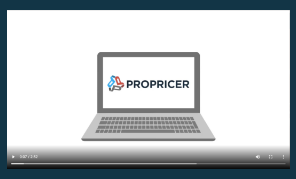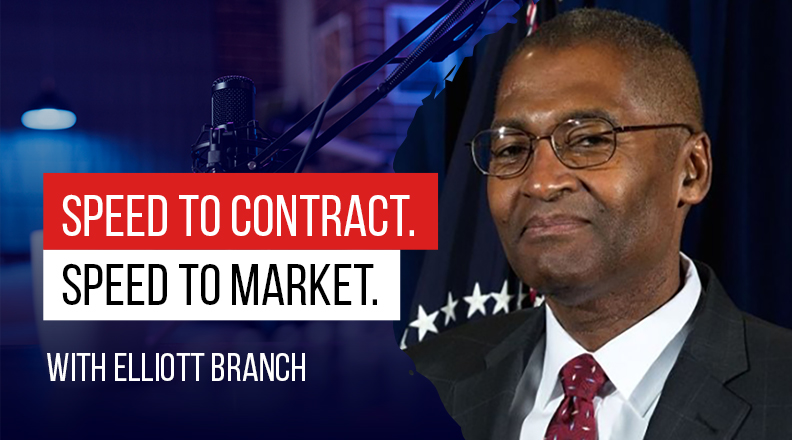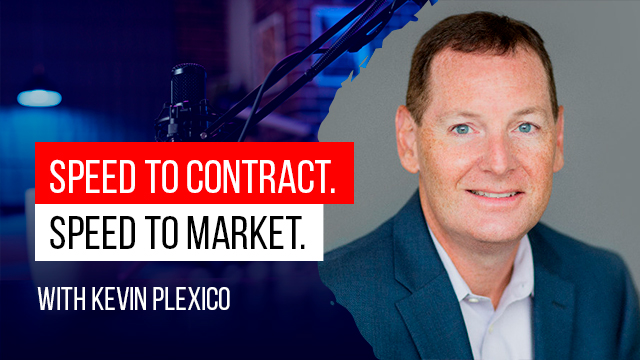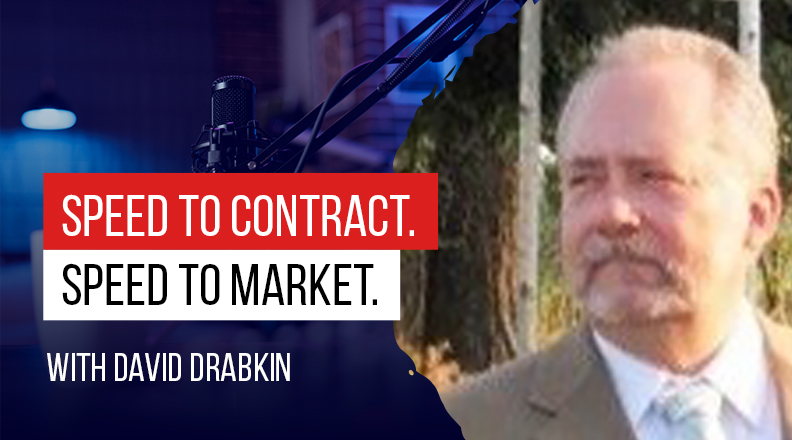How can Other Transaction Authorities (OTAs) shift the US government’s acquisition process into overdrive? In a recent Speed to Contract, Speed to Market video podcast, host Tim Templeton gets the drop from Stan Soloway, former DoD Acquisition Official and CEO of the Professional Services Council. Soloway discusses the possibilities of bringing OTAs into daily contracting use, leveraging CSOs as another powerful yet underused strategy, and embracing corporate training models to educate the next wave of government employees.
We’ve edited the below comments for brevity and clarity.
OTAs work well in emergencies. Why not day to day?
I have a very simplistic view of how we drive greater speed, efficiency, and performance in the acquisition process. I look at things we've done in emergencies and how the system has responded when needed. Of course, the most famous in recent years is the COVID-19 vaccine—a product of OTA development.
I asked myself, “Well, what did we do there—that enabled us to get results so quickly—that is different from what we traditionally do? Why are we not mimicking that in traditional acquisition along with fixes, if you will, where problems may have emerged because of weaknesses or gaps?”
Why is it insufficient day-to-day if it's good enough in an emergency? That doesn't mean we waive audit requirements or compliance. In public procurement, these are essential components. But there are so many examples where the OTA system has performed admirably.
Here’s my point: I don't think we do a very good job of looking at these things we've done in really exigent circumstances to figure out how we could mirror or mimic them day to day.
Less about a specific tool. More about what we learned.
Are we going to use OTAs for everything in procurement? Of course not. Although I challenge people to tell me where OTAs are not appropriate because the question of appropriateness is determined, in my view, solely by whether or not a tool meets the basic tests of public procurement, the ethos of public procurement—transparency, competition, outcomes, et cetera.
Why wouldn't you use it more commonly if a tool meets them? I’m not saying we should use OTAs everywhere. It's that, again, we have a tool that has led to other tools, which I'll talk about in a second. It’s a tool delivering value but struggling to get over the finish line to become a near-peer capability to the FAR-based competitions.
What holds us back from using OTAs effectively?
What is holding us back? In the report a colleague and I did a year and a half ago, we examined the questions, “Does it meet the tests of federal procurement, the ethos of federal procurement? If not, where do we need to improve?” And then second, “Why are we not getting more results out of OTAs?”
Spending through OTAs has gone from $500 million seven or eight years ago to $13 or 14 billion more recently. But I don't want to suggest that OTAs are the panacea. However, we can learn things from them that inform how we progress.
The last point I'll make: There are pieces of the OTA process, mainly practiced by the Defense Innovation Unit, that are now mirrored through statutory authority elsewhere.
CSOs: another underused tool
The main one is called a Commercial Services Offering or CSO. A CSO process is the front-end piece of an OTA. It’s used when a customer puts out a problem statement, invites people to come in with how they would address that problem, and then that customer selects one or more to move forward with prototyping. The FAR covers it; it's a performance-based approach to awarding contracts and should lead you to a performance-based acquisition.
In this light, the CSO is a tool that is also underused, and the question becomes, “Why?” To the point of people responding, “The tools are there to use,” I'm hesitant even to say that because that was the line you heard from people who didn't agree with all the acquisition reforms of the 90s, the 2000s, the 2010s, and so forth.
Many said, “No, we don't need more reform. All the tools are there.” Well, they weren't there way back. They are there now. Some of them are severely watered down. I think the 809 Panel identified some areas a couple of years ago, particularly around commercial. And we've taken two steps forward, maybe a step and a half backward, but they're there. The question is, “How do we now capitalize on them? And what can we learn from what's happening in the workspace?"
Caution: We’re still having trouble transitioning OTAs to production
OTAs are primarily an R&D tool that we've been pushing for years. I pushed for it when I was in office in the late 90s to get what we called “production authority.”
In other words, once I get a non-traditional contractor in the game, I want to take that company through the entire development-to-market process with the same terms and conditions I had to start. Otherwise, you go back under the FAR—and the problem of them potentially walking away happens.
Authority granted: Go full-production
Finally, the government granted this authority several years ago. Yet only some programs have gone into production. There have been a few, but they —and I've talked to companies that have taken them forward—have been very painful. The authority has required huge companies to make difficult compromises they would not ordinarily have made.
Once you roll out of that prototype environment into a production capability, which the law now provides, the tendency to throw FAR clauses back into the production contract sort of submarines the whole intent of what an OTA is, to begin with.
Over the years, Congress has repeatedly and specifically said, “No, you don't need to do that.” But the system—and here we’re starting to look through a culture lens— maintains a hold on a couple of different pieces of the puzzle, and they're not easy. But there is some encouraging work that’s happening.
The Defense Acquisition University (DAU) is working hard on a more robust curriculum around alternative acquisition tools. They're making a serious effort along those lines.
The FAR isn’t the foundation for fed procurement
I would offer an observation, and I can say this now because I have a lot of gray hair, and I'm not back at the beginning of my career: The FAR isn’t the foundation of the future.
If we start with the premise that the FAR is the foundation for federal procurement, we're starting from the wrong foundation if you want to change the culture. Here's the analogy I'll draw: If you go back 25 years, and even in more recent years, some of the most significant reforms have involved getting away from certifications on contracts and mil specs and what we used as an equivalent language. So you must be Capability Maturity Model Integration (CMMI) Level X or equivalent.
The “or equivalent” was the key, as there were other ways to achieve the same outcome. We ought to approach the FAR the same way. The FAR or equivalent gives me what I need from a public procurement perspective. And we begin thinking and training towards that sort of duality—as it can happen under the FAR, yes, but in some cases, it's much better to do it under a non-FAR contract.
So, it concerns how we orient people from day one. If they're introduced to the FAR as the priority regulation set, everything else is an afterthought or an “alternative.” It's sort of like the company that sets up an innovation center in Austin, Texas, and it sits there in Texas and does some cool stuff, but it's never really embedded into the company's operations and DNA. We've got to find a way to blend the two—the FAR and its alternatives. And again, it's not easy to do. But I do think it has to do with how we recruit and train.
I've been in a lot of conversations about the need for more mentors in the acquisition system, which I one hundred percent agree with.
A lot of my colleagues are great mentors. But I think we’ve got to be careful who the other mentors are, too. Because if it's a mentor that is my age, who's been in the system for a long time and is used to legacy protocols, what are they mentoring toward? Are they mentoring toward understanding the system? Or are they mentoring critical thinking and how to take on the system, if you will, in a productive way? I don't mean radically. So it's about education. It's about the way the system thinks of itself.
And then the last piece is about focusing on organizations, not just individuals. Acquisition organizations are not just acquisition people. They're engineers, contracting officers, program managers, lawyers, accountants, and logisticians. It's a multi-functional exercise called a “capital A acquisition.”
Unless that whole organization has a similar orientation to what we're trying to accomplish, we’re never going to change the organization's culture, which means the individual functions within that organization will have to adapt to the dominant culture, right? It's like an organism.
I don't take any credit for this, but a group of folks led by a couple of friends of mine, mostly government acquisition folks, a few years ago came up with a concept called “Acquisition of the Future.” It was kind of a best practices approach that laid out a roadmap. But what they zeroed in on, which I think was the most critical piece, was, “We've got to think about acquisition from an organizational perspective. Much as we think of other things like software development.
As an individual entity, does my organization have the capacity for it? Is it mature? So, think organizationally about the outcomes and characteristics at different levels. How do you build within the model to get there? It does no good If I have a creative 1102 and a rather stuck-in-the-mud program manager or vice versa, or a customer who wants outcome A but is told by someone in Legal or Finance Contracting, “We can't do that.” None of it works, right?
And so, we have to rethink the development model as an organizational one. And as much as I know people have some antipathy towards Amazon and the giant companies, one thing Amazon does right: Customer input underpins everything they do. And that's organizational; that's not just you or me as individuals in the system. We need to start with that.
Training a young workforce of several 100K
The average experience level in government procurement is around five years or less. It's a relatively young workforce. From a timing perspective, we're running out of time in the acquisition community because it's early in the career when we need to get people imbued in a way of thinking.
Once they get to 10 years or 12 years in the system—and this is not a criticism of acquisition people—we all get sort of, “That's how we do it.” I mean, I'm the same way. So, there's a time sensitivity there, there's a time sensitivity in terms of global threat, whether it's the China threat, or frankly things like global warming and other major existential issues that require, regardless of what you think the actual solutions are, rapid action and creative thinking.
Technology will settle nearly every issue
Almost everything we're talking about now, technology will settle. That may sound simplistic, but think about the role of Space Force and non-kinetic warfare—I'm just talking about the national security side. What a general said several years ago at a forum I was at has come home in significant ways. “The future's not about the skin; it's about the man-machine interface inside the skin.” In other words, whether it's a plane, a drone, a ship, or a tank, it's all about the technology. And most of the technology we're looking at is in development by the private sector.
Tech innovation comes from the commercial space
This has been true for 50 years: Tech innovation grows from commercial companies. We crossed that Rubicon back in 1976, the first time the private sector spent more than the public sector in R&D.
But we've never fully adapted to that reality. So that's another piece of the pie. What that points to is, “How do you do things more quickly? I don't know that I have an excellent glib answer to that. I look at some things that people like Hondo Guerts did when he was running acquisition in the Navy around OTAs only—I think it's a model that has other relevance.
He decided that to accelerate change, innovation, and creativity, rather than trying to retrain 1102s, his OTA agreements officers would be people who were not 1102s, so they didn't come in burdened by whatever it is that had “layered onto” them throughout the development of their career.
That's not to say there aren’t great 1102s; I've met many. But Hondo was trying to accelerate the process. Didn't necessarily go all that far, by the way. Because there are a lot of challenges in doing that.
One way DARPA (Defense Advanced Research Projects Agency)—the largest user of OTAs—innovated was to establish a process of essentially testing the agreement workforce. It wasn't just an automatic “other duty” as assigned; there was some degree of winnowing out people with different ways of thinking. So, there are things you can do to prime the engine.
Let me back up to one more point. While at the Defense Department, DAU was part of my organization, and I developed a deep respect for what they were trying to do.
Model how corporate universities train
When you think about the challenge DAU has, it's enormous. And it was slow to adapt for a long time. The university has picked up steam under Jim Woolsey over the last few years.
But one of the things that I've always felt with DAU is, as good as it's getting or as much as it's getting better, one of the commercial best practices where companies have driven change is through how they handle developing their workforce. And it is through corporate universities. Permanent faculties don’t populate corporate universities. Courses are taught almost exclusively by active practitioners who, as part of their job, come into the university for a week, two weeks, four weeks every several years, or whatever the cycle might be, to share what is going on that day in the marketplace and to help develop a workforce for the moment they're in.
That's an area that DAU has struggled with. We looked at trying to convert it to a corporate university structure 20 years ago. China has embedded much more of that, which is very difficult to do in our government. Commercial business doesn’t always have people readily available, so you can’t always take a top-notch program manager and say, “I need you to leave the job for a month.” You know, it's tough. But if you think about it from a long view, you could build a workforce strategy around it. And that would begin to get at culture as well.
Government can learn from Flex Corp’s process
Flex is the second or third-largest manufacturer in the world. They're not as big as Foxconn, but they're up there. They make something like 3000 products at 150 manufacturing facilities all around the globe. They make everything for almost everyone— for Dyson, Google, and others. They also do contract research and development-partnered research and development.
They’re a fascinating company. But what especially intrigued me about Flex was how they approached the supply chain. And I think about this in the context of the government model.
They recognized—now we're talking probably at least 10 or 12 years ago—that if they could reduce inventory in the factory by one day a year, it was $75 million of free cash to the bottom line.
Now, we don't measure things that way in the federal government. But the mentality is what’s valuable. What does it mean to reduce inventory? What does Speed to Delivery result in? Does it have a mission impact on the government? Does it have a mission impact in the national security space? An effect on natural disasters or service to veterans? I mean, there are clearly outcome impacts.
As I learned more about what they were doing, they created—and it didn't exist in the commercial space—their own capability of integrating 90-odd applications. It requires some significant engineering strength. If Application A is where I focus, let's say it’s for in-transit visibility, and a better application emerges, I unplug and plug in with some engineering requirements. Of course, it’s never that simple, but you get the idea.
It's a very dynamic, agile model. As the Washington Post article on Flex pointed out, Flex could manage and, most importantly, predict and anticipate supply chain shortages and issues much more quickly and much further in than almost anybody else. And many times, what’s critical is not just knowing you have a supply chain issue. It's knowing well in advance and being able to predict its impact.
Flex is relevant to this conversation because the guy who designed that whole system for them, who's globally known in the supply chain world, has been “in” multiple times and invited to talk to the military. I know for a fact, as I was working with a spinoff of Flex for a while. Defense Innovation University folks are right out there with them in Silicon Valley, going to visit Flex to learn what they are doing.
People are blown away by it.
Flex built a model that government could emulate
I keep asking, “Why can we not get some of that?” We keep spending a lot of money to invent bespoke solutions. And what Flex has done rather brilliantly is identify the solutions that meet their needs and transform their internal business processes to meet them.
As a result, the CEO or any executive at Flex can pick up their phone any morning, hit the app, and know every supply chain interruption they have, who's responsible for addressing it, and what progress is in motion towards closing it. Incidents are listed by severity, so those involved don't see every little one but see anything graded at the viewer’s level. It's transparent, it's dynamic, it's agile.
We'd love to see a process like this used more in the government. But agencies need help to figure out how they can adapt. And now Flex has an interest in selling that model. The model they built is one government agencies could emulate.
Resource
ProPricer Webinar: Understanding the DoD’s Other Transaction Authorities
Speed to contract. Speed to market. Book your ProPricer demo. Contracting firms: Struggling with complex proposals? ProPricer's advanced software streamlines pricing challenges, speeding you to contract and market. Boost efficiency now. Schedule your demo today >
Save the Date: Government Contract Pricing Summit
June 11 - 13, 2024
Discover the latest trends in government contracting and learn from industry leaders at the upcoming Government Contract Pricing Summit. Whether you attend in person or virtually, you’ll gain a wealth of contract pricing information.
See fascinating keynote sessions and live panel discussions on Speed to Contract, Speed to Market, and more. Hear enlightening talks from subject matter experts working for government agencies, industry contracting firms, and private consulting businesses. Learn more >
Sources
Speed to Contract. Speed to Market: Video Podcast featuring Stan Soloway




